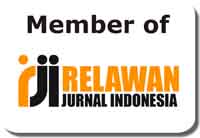Writing Composition Problem in Arabic Language Learning Among Arabic Language Education Students
Abstract
Learning foreign languages, especially Arabic, is still an obstacle for non-Arabic speakers. Apart from the problem of grammatical gaps, and phonological differences between source and target languages, writing composition proficiency is also a problem in learning arabic that often occurs, especially among Arabic language learners in higher education. Anchored by this problem, this study aims to investigate errors in the practice of arabic sentences composition made by learners at the university level, as well as the factors behind it. To explain this problem, the Error Foreign Language (EFL) approach to the content of insyā’ (writing/composing) assignments written by students in Arabic courses are involved as an analytical framework. The results of the analysis reveal that the types of tarkīb errors that appear in students’ assignments include; First, errors in the use of the letters jār, tarkib iḍāfī, tarkīb waṣfī, tarkīb jumlah fi’liyah, and tarkīb jumlah ismiyah that consist of mubtada’ (subject of the sentence) with khabar jumlah fi’ilyah, and mubtada’ with khabar mufrad. The factors that cause this are the result of interlingual interferences, inadequate learning, simplification, and fault analogy in Arabic language rules. The implications and recommendations for this problem are described intensely at the end of this study.
Keywords
Full Text:
PDFReferences
Abi Samra, N. (2003). An analysis of errors in Arabic speakers’ English writings. Investigating Writing Problems among Palestinian Students Studying English as a Foreign Language. Unpublished Doctoral Dissertation.
Adila, W. (2019). A written grammatical error analysis of second year students of Arabic. Arabi: Journal of Arabic Studies, 4(1), 31–44.
Ainin, M. (2011). Analisa Bahasa Pembelajar Bahasa Arab Sebagai Bahasa Asing: Kajian Analisis Kontrastif, Kesilapan, dan Koreksi Kesilapan. C.V. Bintang Sejahtera.
Al-Bannan, M. (2015). Taḥlīl al-Akhtā’: Muqāranah Lisaniyyah li Ta’allum al-Lugah al-’Arabiyyah. Dār al-Kunūz al-Ma’rifah li al-Nasyrī wa al-Tauzī’.
Al-Khūlī, M. (1982). Dirasāt Lugawiyāt. Dār al-’Ulūm.
Al-Shahrani, H. M. (2018). Mother Tongue Interference: A study of Interlingual Errors in The Written Performance of the EFL Preparatory Year Female Students At Al-Baha University in Saudi Arabia. The Humanities and Social Science Journal, 2(2), 118–126.
Bahruddin, U. (2017). Taṭawwur Manhaj Ta’līm al-Lugah al-’Arabiyyah wa Taṭbīqiyyah ‘alā Mahārah al-Kitābah. UIN Maliki Press.
Bani-Khaled, T. A. (2014). Standard Arabic and diglossia: A problem for language education in the Arab world. American International Journal of Contemporary Research, 4(8), 180–189.
Brown, H. D. (2000). Principles of language learning and teaching (Vol. 4). Longman New York.
Corder, P. (1981). Error Nnalysis and Interlanguage. Oxford University Press.
Corder, S. P. (1975). Error analysis, interlanguage and second language acquisition. Language Teaching, 8(4), 201–218.
Dajani, B. A. S., Mubaideen, S., & Omari, F. M. A. (2014). Difficulties of Learning Arabic for non-native speakers. Procedia-Social and Behavioral Sciences, 114, 919–926.
Dulay, H., Burt, M., & Krashen, S. (1982). Language Two. Oxford Press.
Dulay, H. (1982). Language two. ERIC.
Elachachi, H. H. (2015). Exploring cultural barriers in EFL Arab learners’ writing. Procedia-Social and Behavioral Sciences, 199, 129–136.
Ellis, R. (1989). Understanding second language acquisition (Vol. 31). Oxford university press Oxford.
Flege, J. E., & Port, R. (1981). Cross-language phonetic interference: Arabic to English. Language and Speech, 24(2), 125–146.
Haniah, H. (2018). Analisis Kesalahan Berbahasa Arab pada Skripsi Mahasiswa Jurusan Bahasa dan Sastra Arab. Arabi: Journal of Arabic Studies, 3(1), 23–34.
Haron, S. C., Ahmed, I. H., Mamat, A., Ahmad, W. R. W., & Rawash, F. M. M. (2016). Challenges in Learning to Speak Arabic. Journal of Education and Practice, 7(24), 80–85.
Huxley, F. C. (1986). Contrasting Semantic Structures in English and Arabic: Problem and Promise in Second‐Language Learning. Anthropology & Education Quarterly, 17(2), 67–99.
Imaniar, F. (2018). Students’ writing errors and what lies beyond them. Langkawi: Journal of the Association for Arabic and English, 4(2), 71–83.
Khuwaileh, A. A., & Shoumali, A. Al. (2000). Writing errors: A study of the writing ability of Arab learners of academic English and Arabic at university. Language Culture and Curriculum, 13(2), 174–183.
Nielsen, H. L., & Carlsen, M. (2003). Interactive Arabic grammar on the Internet: Problems and solutions. Computer Assisted Language Learning, 16(1), 95–112.
Nurhidayati, N., Ali Maksum, M. A., Machmudah, U., & Ismail, M. Z. Bin. (2020). Effectiveness of Problem-Based Learning Model (PBL) to Improve Listening Skill in Arabic Language Courses. International Conference on Learning Innovation 2019 (ICLI 2019), 134–140.
Parera, J. D. (1997). Linguistik Edukasional: Metadologi Pembelajaran Bahasa Analisis Kontrastif Antarabangsa Analisis Kesalahan Berbahasa. Penerbit Erlangga.
Retnawati, H., Rahmatullah, S., Djidu, H., & Apino, E. (2020). Has Arabic Language Learning Been Successfully Implemented?. International Journal of Instruction, 13(4), 715–730. https://doi.org/10.29333/iji.2020.13444a
Reynolds, J. C. (1997). Syntactic control of interference. In Algol-like Languages (pp. 273–286). Springer.
Richards, J. C. (2015). Error analysis: Perspectives on second language acquisition. Routledge.
Shlenova, M., Nesterenko, A., Girich, Z., Konoplenko, N., Boiarska-Khomenko, A., & Korneiko, Y. (2019). Learning RFL and UFL in Ukrainian Universities: Focus on Arabic Students. Romanian Journal for Multidimensional Education/Revista Romaneasca Pentru Educatie Multidimensionala, 11.
Ṣinī, M. I. (1979). Al-Taqābul al-Lugawī wa Taḥlīl al-Akhṭā’. ‘Imādah Syu’un al-Maktabat Jam’iah Mālik Su’ūd.
Sofa, A. R. (2020). Al-Akhṭā’ al-Ṣarfiyyah fī Kitāyyah al-Kitābiyyah al-Lugah al-’Arabiyyah li al-Ṭullāb fī al-Madrasah al-’Āliyyah al-Islāmiyyah Zain al-Ḥasan Qunqūn . , Vol.3 No. 1 , 80. Jurnal Papatung, 3(1), 80–87.
Storch, N., & Aldosari, A. (2010). Learners’ use of first language (Arabic) in pair work in an EFL class. Language Teaching Research, 14(4), 355–375.
Tarigan, H. G. (2011). Pengajaran Analisis Kesalahan Berbahasa. Percetakan Angkasa.
Taylor, B. P. (1975). The use of overgeneralization and transfer learning strategies by elementary and intermediate students of ESL 1. Language Learning, 25(1), 73–107.
Thompson‐Panos, K., & Thomas‐Ruzic, M. (1983). The least you should know about Arabic: Implications for the ESL writing instructor. Tesol Quarterly, 17(4), 609–623.
Touchie, H. Y. (1986). Second language learning errors: Their types, causes, and treatment. JALT Journal, 8(1), 75–80.
Ṭu’aimah, R. A. (1989). Ta’lim al-Lugah al-’Arabiyyah li-Gair al-Naṭiqīn Bihā wa Manāhijuh wa Asālibuh. Isisko.
Warsito, W., & Harahap, A. (2017). Stating and defending new knowledge claim: A rhetorical analysis on the discussion section of English Master thesis By Indonesian EFL learners. IJEE (Indonesian Journal of English Education), 4(2), 188–207.
Wulandari, N. (2020). Analisis Kesalahan Fonologis Dalam Keterampilan Berbicara Bahasa Arab. Jurnal Al-Fathin, 3(1), 71–84.
Yusuf, M. (2018). Teaching and Learning Arabic and Quran through Ecletic Method in Islamic School. International Journal of Pure and Applied Mathematics, 119(18), 915–927.
Zaid, A. H., Bahroni, I., & Haq, A. H. (2019). An Application of Arabic Language Teaching Based on Error Analysis Theory. http://eprints.eudl.eu/id/eprint/6673/
DOI: http://dx.doi.org/10.31332/lkw.v0i0.3399
Copyright (c) 2022 Zulaeha Zulaeha

This work is licensed under a Creative Commons Attribution-ShareAlike 4.0 International License.
Langkawi: Journal of The Association for Arabic and English indexed by:


















.png)
.png)

.png)
2.png)








